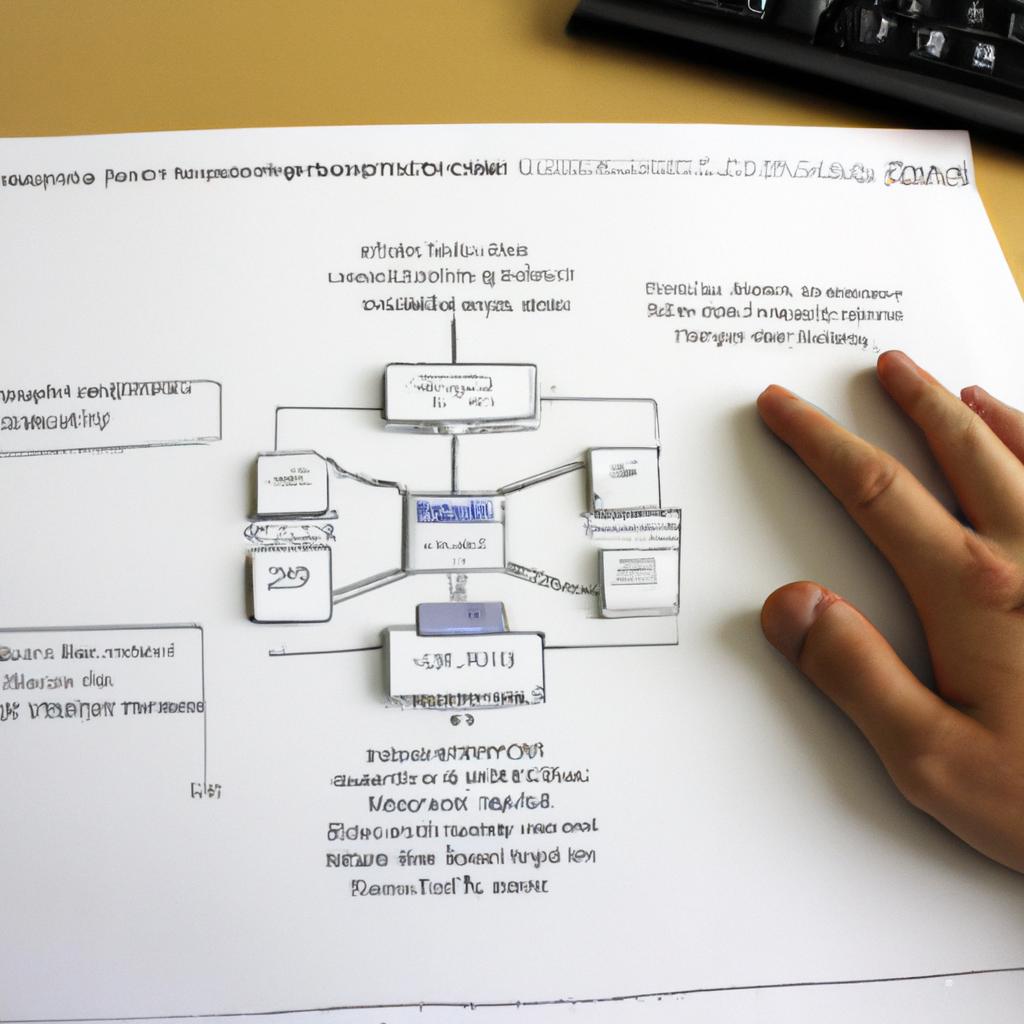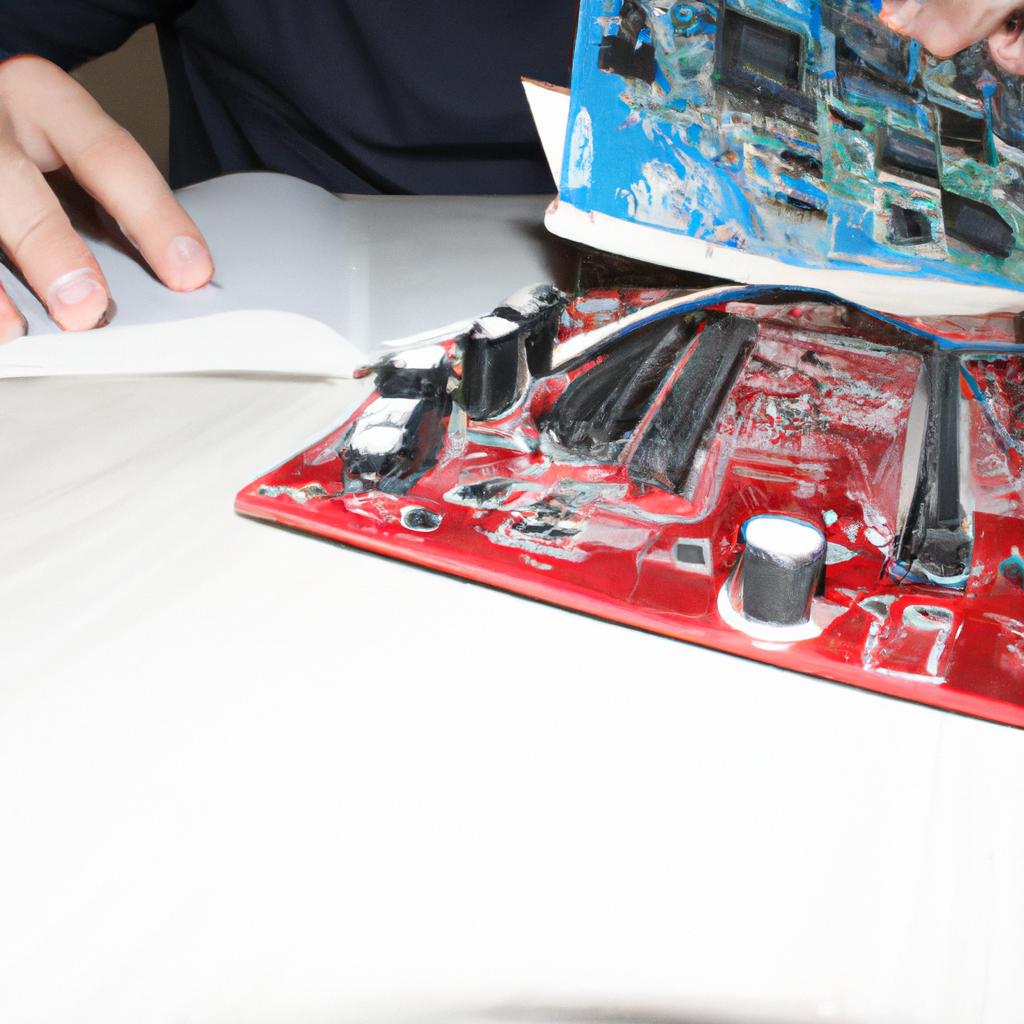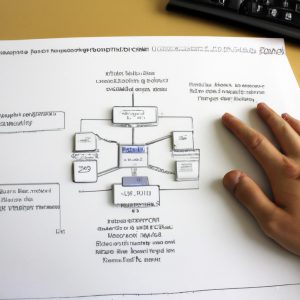Parallel Processing in Computer Architecture: Efficient Hardware for Enhanced Performance
Parallel processing in computer architecture is a vital area of research that aims to enhance the performance and efficiency of modern computing systems. By utilizing multiple processors or cores simultaneously, parallel processing allows for the execution of multiple tasks concurrently, thereby significantly reducing the overall completion time. For instance, consider a hypothetical scenario where a complex scientific simulation needs to be performed on a supercomputer with only single-core processors. The computation would take an exorbitant amount of time to complete due to its sequential nature. However, by employing parallel processing techniques, such as dividing the task into smaller subtasks and assigning them to different cores, the simulation can be completed much faster.
The quest for efficient hardware solutions in parallel processing has gained significant momentum over the years due to several factors. First and foremost is the increasing demand for high-performance computing applications across various domains like data analytics, artificial intelligence, and scientific simulations. These computationally intensive tasks require massive amounts of computational power and can benefit greatly from parallel processing architectures. Furthermore, advancements in semiconductor technology have enabled the integration of multiple processor cores onto a single chip, allowing for greater scalability and cost-effectiveness in implementing parallel architectures. Additionally, energy consumption has become a critical concern in modern computing systems; parallel processing offers opportunities for optimizing power usage by utilizing idle resources and distributing the workload among multiple cores, thereby reducing energy consumption.
There are different approaches to implementing parallel processing in computer architecture. One common method is called task parallelism, where a large task is divided into smaller independent subtasks that can be executed concurrently on different cores or processors. Another approach is data parallelism, where the same operation is performed on different data sets simultaneously using multiple cores. This approach is often used in graphics processing units (GPUs) for tasks like image rendering or machine learning algorithms.
Parallel processing also requires efficient communication mechanisms between processors or cores to coordinate their activities and exchange data. Shared memory systems allow multiple processors to access the same memory space, enabling fast communication and data sharing. On the other hand, distributed memory systems require explicit communication between processors through message passing, which allows for scalability but adds overhead due to data transfer.
To take advantage of parallel processing, software developers need to design their applications with parallelism in mind. This involves identifying portions of code that can be executed concurrently and implementing appropriate synchronization mechanisms to ensure correct results. Parallel programming languages and libraries, such as OpenMP and MPI, provide tools and APIs that simplify the development of parallel applications.
In conclusion, parallel processing plays a crucial role in enhancing computing performance and efficiency by leveraging multiple processors or cores to execute tasks concurrently. It addresses the increasing demand for high-performance computing applications while optimizing power usage. Implementing parallel architectures requires efficient hardware designs and software development practices that leverage task or data parallelism and utilize suitable communication mechanisms between processors or cores.
Overview of Parallel Processing
Parallel processing is a technique used in computer architecture to improve the performance and efficiency of computing systems. By dividing complex tasks into smaller subtasks that can be executed simultaneously, parallel processing allows for faster execution times and increased throughput. To illustrate its benefits, let us consider an example: imagine a scenario where a single processor is responsible for executing multiple computational tasks concurrently. Without parallel processing, each task would have to wait for the completion of the previous one before it could start, leading to significant delays and lower overall system efficiency.
To fully comprehend the significance of parallel processing, it is essential to understand its advantages over traditional sequential processing methods. Firstly, parallel processing enables efficient utilization of available resources by distributing workloads among multiple processors or cores. This distribution ensures that all components are continuously active, maximizing their potential and reducing idle time. Secondly, this technology enhances speed and responsiveness by allowing several tasks to execute simultaneously rather than waiting for each other’s completion sequentially. Consequently, the overall time required for completing complex computations significantly decreases.
The emotional impact of these advancements becomes apparent when considering the following bullet points:
- Increased productivity: Parallel processing minimizes computation time, enabling more work to be completed within shorter periods.
- Enhanced user experience: The improved speed provided by parallel processing results in smoother interactions with software applications and reduces latency issues.
- Cost-effectiveness: Utilizing hardware efficiently through parallel processing leads to optimal resource allocation, resulting in reduced energy consumption and cost savings.
- Scientific breakthroughs: Complex simulations and data-intensive scientific research benefit from parallel processing as large-scale calculations can be performed at accelerated speeds.
| Aspects | Benefits |
|---|---|
| Speed | Faster execution times and reduced response delays |
| Efficiency | Optimal use of available resources |
| Scalability | Ability to handle larger workloads and increasing demands |
| Flexibility | Adaptability to different application requirements |
Understanding the potential of parallel processing lays the foundation for exploring various types of parallelism that exist in computer architecture. In the subsequent section, we will delve into these different categories and examine their respective characteristics and applications.
Types of Parallel Processing
[Transition sentence] Now that we have established an overview of parallel processing’s significance, let us move on to discuss its underlying types and explore how they are implemented in computer architectures.
Types of Parallel Processing
Section H2: Types of Parallel Processing
Building upon the understanding of parallel processing outlined in the previous section, it is essential to delve into the various types of parallel processing techniques employed in computer architecture. These techniques aim to enhance performance and efficiency by dividing complex tasks among multiple processors or cores, enabling simultaneous execution. To illustrate this concept further, let us consider a hypothetical scenario.
Imagine a data-intensive application that requires extensive computations on large datasets. In traditional sequential processing, this task would involve sequentially executing each computation one after another, resulting in significant latency delays and inefficiencies. However, with parallel processing techniques, such as task parallelism or data parallelism, the workload can be divided among multiple cores or processors for simultaneous execution. This division enables faster completion times and improved overall system performance.
Types of parallel processing include:
-
Task Parallelism: In this approach, different tasks or subtasks are executed concurrently using separate resources. Each task operates independently but contributes towards achieving an overarching goal. For example:
- Task 1: Data preprocessing
- Task 2: Feature extraction
- Task 3: Model training
- Task 4: Prediction generation
-
Data Parallelism: With data parallelism, large datasets are split into smaller subsets processed simultaneously across multiple processors/cores. This technique is particularly effective when dealing with applications that require extensive computations over vast amounts of similar data.
-
Pipeline Parallelism: Here, the entire computational process is broken down into stages or steps connected through a pipeline structure. Each stage performs its specific function on input data before passing it along to subsequent stages for further processing.
-
Hybrid Models: Some scenarios benefit from combining multiple types of parallel processing approaches to capitalize on their strengths while mitigating limitations.
To provide a visual representation comparing these types of parallel processing techniques:
| Technique | Description |
|---|---|
| Task Parallelism | Divides tasks into independent subtasks executed concurrently. |
| Data Parallelism | Splits data into subsets for simultaneous processing on multiple resources. |
| Pipeline Parallelism | Breaks down computation into stages connected through a pipeline structure. |
| Hybrid Models | Combines different parallel processing approaches for optimal performance. |
Understanding the various types of parallel processing techniques paves the way for exploring the benefits and implications they offer, as discussed in the subsequent section: “Benefits of Parallel Processing.” This exploration will shed light on how these techniques can revolutionize computer architecture and bring about enhanced performance across various domains.
Benefits of Parallel Processing
Imagine a scenario where a video editing software is processing multiple high-definition videos simultaneously, applying filters and effects in real-time. This demanding task requires immense computational power and efficient utilization of resources. The solution lies in parallel processing, which enables the execution of multiple tasks concurrently to achieve faster and more efficient computation.
To harness the full potential of parallel processing, computer architects have developed various techniques and hardware designs that aim to optimize performance. These advancements not only enhance the speed at which computations are carried out but also improve energy efficiency and overall system reliability.
Firstly, one key aspect of optimizing parallel processing is load balancing. By distributing computational workloads evenly across different processing units or cores, it ensures that no single unit becomes overwhelmed while others remain idle. This balance allows for maximum resource utilization, minimizing bottlenecks and maximizing throughput.
Secondly, another important factor in enhancing performance is interconnectivity. Efficient communication between different processors or cores plays a crucial role in achieving optimal results. High-speed interconnections enable fast data transfer between components, reducing latency and improving overall system responsiveness.
Thirdly, memory access optimization is vital for efficient parallel processing. Memory hierarchy design aims to minimize data transfer time by utilizing caching mechanisms that store frequently accessed data closer to the processor cores. This reduces the need for frequent trips to main memory, resulting in significant performance gains.
Lastly, fault tolerance measures must be implemented to ensure reliable operation even in the presence of hardware failures or errors during parallel processing. Techniques such as redundancy or error-checking mechanisms help detect and recover from faults without compromising system integrity.
Benefits of Optimized Parallel Processing
Parallel processing offers numerous advantages over traditional sequential computing methods:
- Enhanced Speed: With multiple tasks executed simultaneously, parallel processing significantly reduces computation time.
- Improved Scalability: As workload increases, additional processors can be added seamlessly to handle increased demand without sacrificing performance.
- Increased Throughput: By dividing tasks into smaller subtasks and processing them concurrently, parallel processing allows for a higher volume of work to be completed within a given time frame.
- Energy Efficiency: Properly designed parallel processing architectures can optimize resource utilization, minimizing power consumption while delivering high performance.
| Benefit | Description |
|---|---|
| Enhanced Speed | Parallel processing enables faster computation by executing multiple tasks simultaneously. |
| Improved Scalability | The ability to seamlessly add more processors ensures that the system’s performance scales with increasing workload. |
| Increased Throughput | Dividing tasks into smaller subtasks and processing them concurrently allows for a higher volume of work to be completed in less time. |
| Energy Efficiency | Optimized resource utilization reduces power consumption while maintaining high performance levels. |
As we have explored the benefits of optimized parallel processing, it becomes clear how this approach is crucial in modern computing systems.
[Transition] Now let us turn our attention to the challenges encountered during the implementation of parallel processing methods and ways to overcome them effectively.
Challenges in Parallel Processing
Building upon the discussed benefits of parallel processing, it is crucial to acknowledge that this approach also presents several challenges. Understanding these hurdles can guide researchers and engineers in developing efficient hardware architectures for enhanced performance.
One significant challenge faced in parallel processing is the issue of load balancing. In a parallel computing system, tasks are distributed among multiple processors or cores to be executed concurrently. However, not all tasks can be equally divided and processed simultaneously, leading to an imbalance in workload distribution. This imbalance can result in some processors being underutilized while others become overwhelmed with excessive workload. For instance, consider a scenario where one processor receives computationally intensive tasks while another remains idle due to less demanding operations. Such discrepancies hinder overall system efficiency and can lead to increased execution time.
Another obstacle encountered in parallel processing relates to inter-process communication and synchronization. When multiple processes are executing concurrently, they often need to exchange data or coordinate their actions at specific points during computation. Ensuring proper coordination between different processes becomes critical for achieving correct results and preventing conflicts or race conditions. The complexity of managing these interactions increases as the number of processors involved grows. Efficient techniques for inter-process communication must be implemented to minimize overheads associated with data transfer and synchronization.
Furthermore, scalability poses a significant challenge when designing hardware architectures for parallel processing systems. Scalability refers to the ability of a system to handle increasing workloads by adding more resources without sacrificing performance or efficiency. As the number of processors scales up, factors such as memory access latency, resource contention, and power consumption become more pronounced. Designing scalable architectures requires careful consideration of various aspects, including cache coherence protocols, memory hierarchies, and network topologies.
- Increased computational power leads to faster scientific discoveries.
- Improved simulation capabilities allow for accurate weather forecasting.
- Enhanced image rendering enables realistic virtual reality experiences.
- Quicker financial modeling facilitates informed investment decisions.
Emotional Table:
| Benefit | Example |
|---|---|
| Faster | Reduced time for complex calculations |
| Accurate | Improved prediction of natural phenomena |
| Realistic | Lifelike graphics in video games |
| Efficient | Streamlined data analysis processes |
Understanding the challenges faced in parallel processing lays the groundwork for exploring effective techniques to overcome them. In the subsequent section, we will delve into various parallel processing techniques that have been developed to enhance performance and address these obstacles head-on.
Parallel Processing Techniques
Parallel processing, although promising improved performance, poses several challenges that need to be addressed for efficient utilization of hardware resources. In this section, we will explore these challenges and discuss the strategies employed to overcome them.
One major challenge in parallel processing is data dependencies. When multiple tasks are executed simultaneously on different processors or cores, they may require access to shared data. However, if one task modifies the shared data while another task is still using it, inconsistencies can arise. To mitigate this issue, synchronization mechanisms like locks and semaphores are used to ensure exclusive access to shared resources.
Another challenge lies in load balancing across multiple processors. In a parallel system, the workload needs to be evenly distributed among the available processors to achieve optimal performance. Uneven distribution can lead to some processors being underutilized while others are overloaded. Load balancing techniques such as dynamic scheduling and work stealing algorithms aim to distribute tasks efficiently among processors based on their current workload.
Furthermore, communication overhead between processors can significantly impact performance in parallel systems. As tasks are divided and assigned to different processors for execution, inter-processor communication becomes necessary for coordination and sharing of results. Minimizing communication overhead involves optimizing message passing protocols, reducing network latency, and increasing bandwidth.
To illustrate these challenges more vividly:
- Imagine an image rendering application where each pixel’s color value is determined by complex mathematical calculations involving neighboring pixels’ values.
- The table below demonstrates how varying degrees of load imbalance affect the overall efficiency of executing a computational task across four processors.
| Processor | Task Completion Time (in seconds) |
|---|---|
| P1 | 10 |
| P2 | 8 |
| P3 | 12 |
| P4 | 9 |
These challenges emphasize the complexity involved in achieving efficient parallel processing. Overcoming these hurdles requires innovative hardware architectures and sophisticated algorithms.
Transitioning into the subsequent section on “Applications of Parallel Processing,” it becomes evident that understanding and addressing the challenges in parallel processing is crucial for unlocking its full potential across a wide range of applications. By overcoming data dependencies, optimizing load balancing, and minimizing communication overhead, parallel processing can revolutionize industries such as scientific simulations, big data analytics, and machine learning.
Applications of Parallel Processing
Building upon the previous section on parallel processing techniques, this section delves deeper into the applications of these techniques in computer architecture. By harnessing the power of parallelism, hardware systems can achieve enhanced performance and efficiency.
One notable example showcasing the benefits of parallel processing is the use of Graphics Processing Units (GPUs) for image rendering in video games. GPUs employ parallel computing to process multiple pixels simultaneously, resulting in faster and more realistic graphics rendering. This enables gamers to enjoy immersive experiences with high-quality visuals and smooth gameplay.
To further explore the potential impact of parallel processing in various domains, consider the following bullet points:
- Scientific simulations: Parallel processing allows for faster execution of complex scientific simulations, enabling researchers to analyze large datasets and make breakthrough discoveries.
- Financial modeling: Financial institutions leverage parallel processing to perform real-time risk analysis, portfolio optimization, and algorithmic trading operations.
- Big data analytics: With increasing volumes of data being generated every day, parallel processing facilitates efficient handling and analysis of big data sets. This leads to valuable insights for businesses across diverse sectors.
- Artificial intelligence: Machine learning algorithms greatly benefit from parallel architectures as they involve intensive computations. Training deep neural networks becomes significantly faster when processed concurrently across multiple cores or nodes.
In addition to these varied applications, a comparison table can help illustrate how different aspects are influenced by employing parallel processing techniques:
| Aspects | Traditional Computing | Parallel Processing |
|---|---|---|
| Speed | Slower | Faster |
| Scalability | Limited | Highly scalable |
| Execution time | Longer | Reduced |
| Resource utilization | Inefficient | Optimal |
By examining the above table, it becomes evident that utilizing parallel processing techniques enhances both speed and scalability while optimizing resource utilization.
In summary, through examples such as GPU-accelerated image rendering and by exploring the applications of parallel processing in scientific simulations, financial modeling, big data analytics, and artificial intelligence, it is clear that efficient hardware architectures play a crucial role in achieving enhanced performance. The incorporation of parallel computing techniques results in faster execution times, improved scalability, and optimal resource utilization – ultimately revolutionizing various domains across industries.





